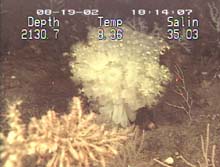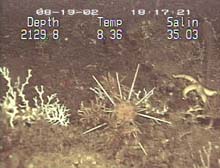“Hagfish, My Biggest Nightmare!”
August 20, 2002
Paula Keener-Chavis
National Education Coordinator
NOAA Office of Ocean Exploration
![]() Watch video of Johnson-Sea-Link II deploying traps. (mp4, 1.3 MB)
Watch video of Johnson-Sea-Link II deploying traps. (mp4, 1.3 MB)
There’s far too much to take in here,
More to find than can ever be found.
But the sun rolling high through the sapphire sky
Keeps great and small on the endless round.
--Elton John, The Circle of Life
"Perfect deployment of the camera, just perfect,” said Edie Widder as she emerged from the submersible at 8:30p.m. The trap deployment was also a success and a glass sponge with zooanthids that luminescence were among the samples collected from a depth of 2,114 feet on the last dive of the day.
As the videotapes of the dive are duplicated and reviewed throughout the evening, fathometer transects continued last night only being interrupted as we ran from several strong squalls. These readings will be imported into ArcView GIS and submersible dive locations and sample collection data will eventually overlay this information as we continue to fill in data gaps to more completely map the site.
At 8:20 this morning, the submersible was in the water to record light readings on its descent, collect samples, and retrieve the baited traps and the camera. Almost four hours later, the submersible surfaces with seven acrylic containers of samples, the four traps, and no camera. Sea conditions are too rough to risk damaging the camera so Widder makes the decision to leave it on the bottom for retrieval early this evening in hopes that the seas will calm some.
The traps are quickly whisked away to the cold room and much to our disappointment, not a single shrimp or crab…. just hagfish. “Hagfish…my biggest nightmare!”, says Tammy Frank. “We saw a small crab just outside of one of the traps while we were in the sub. Since the hagfish were probably the first to enter the trap, the question is, ‘Did the crab even try to get into the trap?’” Since the traps were positioned in front of the camera, we should know the answer to this question once we retrieve the camera on the next dive and have a chance to review the tapes.”
At 4:20p.m., the scientific party and vessel crew prepare for the late afternoon dive. The submersible pilots will attempt to navigate to a site delineated by the fathometer reconnaissance last night. If successful, they should start their bottom work and slow ascent to the surface at the base of pinnacle in 2,500 feet of water.
Interview with LaVern Taylor, Senior Marine Technician, University of Miami
What are your responsibilities on board the R/V Seward Johnson?
I am responsible for all shipboard scientific electronics, satellite communications, and shipboard LAN (Local Area Network).
What kind of training did you get for this position?
I have a BS in Zoology, with a Minor in Chemistry and Geology and a significant amount of coursework toward an MS degree, and I hold a 100 Ton Captain’s License, but all of my skills for this position came from training on the job. I have held this position since February 2000. Prior to that, I was a Marine Technician on the R/V Pelican with the University of Louisiana from November 1998 to February 2000. I would also fill in occasionally in that position as an Assistant Engineer or a Deck Hand.
What do you like most about this kind of work?
I like the challenges. It’s Murphy’s Law – if you put something electronic overboard, sooner or later it’s going to fail. I like trying to figure out what the problem is, fixing it and getting the scientists back to business with equipment that is operational as soon as possible. I also like seeing new things and meeting new people.
How much time do you spend at sea?
I spend about 190-200 days at sea a year, and I am out at about 2-3 weeks at a time.
How did you find this position?
My husband was a scientist who was at sea on the R/V Pelican conducting deep trawls in the Mississippi Canyon in the Gulf of Mexico. He was talking with the Captain of that vessel, who was also Head of Technicians, and he told the Captain, “My wife would just love a job as a technician on this vessel.” I went to pick my husband up the next day when the vessel came back in, and I took a copy of my resume to the Captain. By the time I got home, there was a message telling me that I was hired, not as a deckhand (which was the position I was applying for), but as a Marine Technician, based on my experience.
I left the R/V Pelican and began working on the R/V Seward Johnson in order to gain new experiences. I am now working with different equipment and different groups of scientists. I have new challenges to meet and new experiences to gain.
Sign up for the Ocean Explorer E-mail Update List.


















































